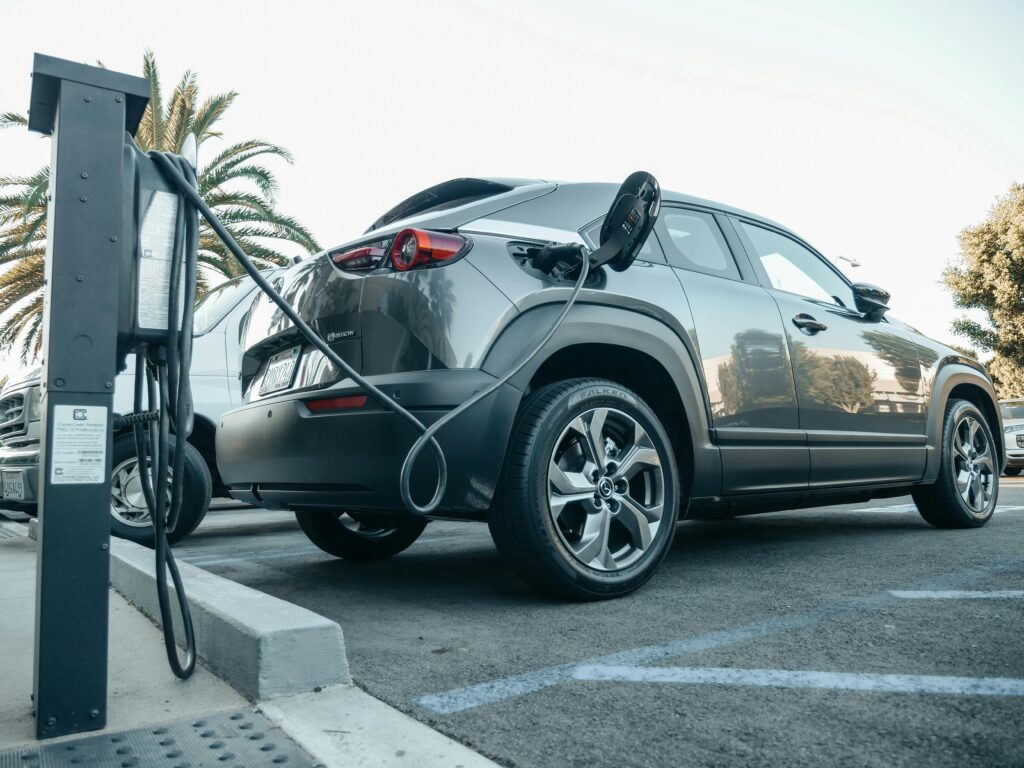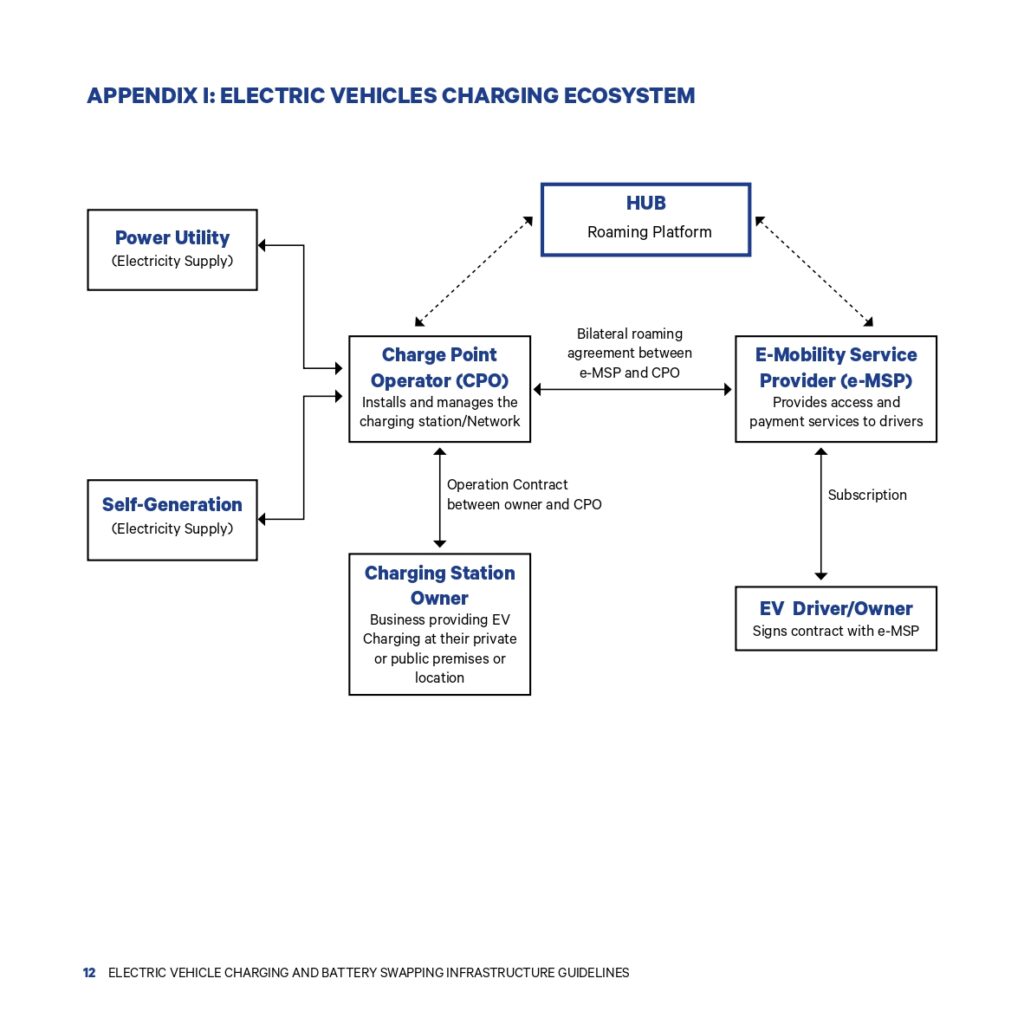Electric vehicle charging in Kenya refers to the process of replenishing the energy stored in the battery of an electric vehicle (EV). It involves connecting the EV to a charging station or point to transfer electrical energy from the grid to the vehicle’s battery, allowing it to operate. Electric vehicle charging infrastructure includes various types of charging stations, such as:
AC Charging Stations: These stations provide alternating current (AC) electricity to the vehicle’s onboard charger, which converts it to the direct current (DC) needed to charge the battery. AC charging is typically slower and is commonly found in residential settings.
DC Fast Charging Stations: Also known as rapid chargers, these stations provide direct current (DC) electricity directly to the vehicle’s battery, bypassing the onboard charger. DC fast charging allows for much quicker charging times compared to AC charging and is often used in public locations along highways and major routes.
Wireless Charging: This technology enables EVs to charge without the need for physical cables by using electromagnetic fields to transfer energy between a charging pad on the ground and a receiver pad on the vehicle. Wireless charging offers convenience and ease of use but is currently less common and typically slower than wired charging methods.
Electric vehicle charging infrastructure plays a crucial role in the widespread adoption of electric vehicles by providing convenient and accessible charging options for EV owners. As the demand for electric vehicles continues to grow, there is a corresponding need for the expansion and enhancement of charging infrastructure to support increased EV usage and address range anxiety concerns among consumers. Additionally, advancements in charging technology, such as ultra-fast charging and vehicle-to-grid capabilities, are being developed to further improve the charging experience and integrate EVs with the broader electricity grid ecosystem.
In the exercise of the powers conferred by sections 11(a)(c)(d), 121(1), 148(1), 151(2), and 163(4)(1) of the Energy Act, 2019, the Authority hereby establishes the following Guidelines:
CITATION AND COMMENCEMENT OF ELECTRIC VEHICLE CHARGING IN KENYA
These Guidelines may be cited as the Electric Vehicle (EV) Charging and Battery Swapping Infrastructure Guidelines, 2023.
DEFINITION OF TERMS
Battery Charging Station (BCS): A station where discharged or partially discharged electric batteries for electric vehicles are electrically recharged.
Battery Swapping Station (BSS): A station where any electric vehicle can have its discharged or partially charged battery replaced with a charged battery.
Battery Management System (BMS): A system that monitors and manages a rechargeable battery (or group of batteries).
Charging Bay: A designated area or space where electric vehicles can be parked and connected to a charging point.
Charging Point: Also known as an Electric Vehicle Supply Equipment (EVSE), it is a component or device in Electric Vehicle Charging Infrastructure (EVCI) that supplies electrical energy for recharging the battery of electric vehicles. A charging point may have one or several connectors to accommodate different connector types.
Charging Point Operator (CPO): An entity that installs and manages the operations of the charging infrastructure. A CPO may own the charging infrastructure or provide services on behalf of the charge station owner.
Charging Station: A site or location with one or more charging points that allows electric vehicles to charge.
Connector: A cable that connects an EV vehicle to an electric charging point.
Electric Vehicle: A vehicle capable of being propelled by electrical power derived from a storage battery.
Electric Mobility Service Provider (e-MSP): An entity with which the EV driver contracts for all services related to electric charging. The e-MSP has various responsibilities, including providing charging passes/cards, applications to locate and navigate charging stations, billing and invoicing, and customer management.
Internet of Things (IoT): The network of physical objects/devices/equipment embedded with sensors, software, and other technologies for connecting and exchanging data with other devices and systems over the Internet.
Public Charging Station (PCS): An EV charging station where any electric vehicle can get its battery recharged.
Smart Charging: A charging system where electric vehicles, charging stations, and charging operators share data connections.
Warranty: A document of assurance or guarantee given to the purchaser or system owner by a manufacturer, vendor, or installer, stating that a product or installation will perform as stated, is reliable and free from known defects, and that the manufacturer, vendor, or installer shall, without charge, repair or replace defective parts within a given time limit and under certain conditions.

LIST OF ACRONYMS
BCS: Battery Charging Station
BMS: Battery Management System
BSS: Battery Swapping Station
CPO: Charging Point Operator
e-MSP: Electric Mobility Service Provider
EPRA: Energy and Petroleum Regulatory Authority
EV: Electric Vehicle
EVCI: Electric Vehicle Charging Infrastructure
EVSE: Electric Vehicle Supply Equipment
FCB: Fluid Cooled Batteries
IoT: Internet of Things
KEBS: Kenya Bureau of Standards
OMCs: Oil Marketing Companies
PCS: Public Charging Station
RO: Retail Outlet
INTRODUCTION TO ELECTRIC VEHICLE CHARGING IN KENYA
The Government of Kenya has undertaken multiple initiatives to promote the manufacturing and adoption of electric vehicles as the country endeavours to achieve its energy transition goals. The Kenya Kwanza administration’s Bottom-Up Economic Transformation Plan 2022-2027 (also known as the Bottom-Up Economic Transformation Agenda), envisages that the Government will construct 1000 electric vehicle charging stations, with 700 in urban areas and 300 along highways.
The importation of electric vehicles in the country began about ten years ago and has mainly been driven by the private sector. There has been a slow uptake of EVs partly due to the following reasons:
Electric vehicles are being deemed expensive compared to internal combustion engine models.
A lack of clarity on the availability of sustainable and affordable energy for electric vehicles.
Accessibility issues are caused by inadequate charging infrastructure.
With Government support, electric vehicles have started to penetrate the Kenyan market. However, there is currently no framework that encourages uptake and penetration through an enabling framework. The Authority has therefore developed the Electric Vehicle (EV) Charging and Battery Swapping Infrastructure Guidelines, 2023. These Guidelines summarize key considerations when siting, designing, installing, and operating electric vehicle charging points and stations.
PURPOSE
The purpose of these Guidelines is:
To make electric vehicle charging infrastructure accessible to all users.
To enable faster adoption of electric vehicles in Kenya by ensuring safe, reliable, accessible, and affordable charging infrastructure and ecosystem.
To promote affordable tariffs chargeable from Electric Vehicle (EV) owners and Charging Station Operators/Owners.
To generate employment/income opportunities for small entrepreneurs.
To proactively support the creation of EV Charging Infrastructure in the initial phase and eventually create a market for the EV Charging business.
To encourage the preparedness of Electrical Distribution Systems to adopt EV Charging Infrastructure.
To create uniformity and certainty towards accelerated adoption of EVs in the Country.
SCOPE
These Guidelines apply to individuals, firms, and institutions intending to install, operate, and maintain a Public/Private Charging Station and Battery Swapping Stations. The Guidelines will also apply to users where applicable.
GUIDELINES FOR ELECTRIC VEHICLE CHARGING IN KENYA
Public Charging Infrastructure Requirements
Any person intending to install a PCS shall be required to apply to the Authority for an electricity retail supply license before such installation.
Any person seeking to set up a PCS may apply for connectivity in the specified area of supply and will be provided with connectivity on a priority basis by the Electric Distribution Licensee. Any Charging Station/Chain of Charging Stations may also obtain electricity from any generation licensee through open access arrangement.
Every PCS shall have the following minimum infrastructure: i. An exclusive transformer and/or electric supply line with all related supply equipment including safety appliances, as required by the Kenya Grid Code. ii. Appropriate cabling and electrical works ensure the safety and stability of the electricity grid. iii. Appropriate civil works. iv. Adequate space for charging and entry/exit of vehicles. v. Appropriate fire protection equipment and facilities. vi. Appropriate public amenities. vii. Practice is generally accepted international standards. viii. The PCS shall have one or more chargers or any combination of chargers from the table below:
| Charger Type | Charger Connectors | Rated Output Voltage (V) | No. of Connector Guns (CG) | Charging Vehicle Type(W=wheeler) |
| Fast Charge (DC & AC) | Combined Charging System (CCS) (> 50 kW) – DC | 200-750 or higher | 1 CG | 4W |
| CHArgedeMOve (CHAde- MO) (> 50 kW) – DC | 200-500 or higher | 1 CG | 4W | |
| Type-2 AC Three – Phase (> 22 kW) | 380- 415 | 1 CG | 4W, 3W, 2W | |
| Moderate and Slow Charge (AC) | Type-2 AC (> 22 kW) | 380- 415 | 1 CG | 4W, 3W, 2W |
| Type-2 AC >3.7kW and ≤ 22kW | 380- 415 | 1 CG | 4W, 3W, 2W |
The CS for two/three wheelers shall be free to install any chargers other than those specified in the table above subject to compliance with technical and safe- ty standards as laid down by the Kenya Bureau of Standards (KEBS) and EPRA.
- The PCS/CPO shall tie up with at least one online e-MSP to enable advance remote/online booking of charging slots by EV owners. Such online information to EV owners should also include information regarding
- electric power distribution licensees and maintain appropriate protocols as prescribed by such companies for this purpose. The Authority shall have access to this data.Where a fast/rapid charging facility is also planned to be provided at the PCS, the following additional infrastructure shall be provided:
- Appropriate Liquid Cooled cables if High-Speed Charging Facility for onboard charging of Fluid Cooled Batteries (FCBs) is also planned.Appropriate Climate Control Equipment for Fast Charging of Batteries to be used for swapping.
The Charging Points shall be certified and type-approved/tested by KEBS or any other accredited agency.
A CS may be installed in residential estates, malls, office complexes, restaurants, hotels, and other similar premises.
The PCS may have the option to add stand-alone battery swapping facilities provided space and/or other conditions permit.
1. Private Charging Infrastructure Requirements
Private charging at residences/offices shall be permitted.
- The minimum public charging infrastructure requirements in Clause 1.3 do not apply to Private Charging Points meant for the self-use of individual EV owners (non-com- mercial basis).Captive charging infrastructure for 100% internal use for a company’s own/leased fleet for its own use will not be required to install chargers that have tie-ups with e-MSPs.The fast/rapid Charging Stations which are meant only for 100% in-house/captive utilization, for instance, buses of a company, would be free to decide the charging specifica- tions as per requirement for its in-house company.Charging Points shall be certified and type-approved/ tested by KEBS or any other accredited agency.Private charging infrastructure shall be operational only after inspection, testing and issuance of a completion cer- tificate issued by a licensed electrical contractor/inspector.
A separate metering arrangement shall be made for charging points so that consumption may be recorded and billed as per the applicable tariff for EV charging.
2. Battery Swapping Stations Requirements for Electric vehicle charging in Kenya
The provision of adequate space for charging and swapping of batteries.
The batteries are required to be BMS-enabled for efficient battery monitoring, data analysis, and safety. The battery swapping provider shall ensure that appropriate BMS is in place to protect the battery from conditions such as thermal runaway.
- To ensure battery safety and security of assets, swappable batteries will be equipped with advanced features like IoT-based battery monitoring systems, remote monitoring & immobilisation capabilities, and other required control features.To implement unique traceability across the battery lifecycle, a UIN shall be assigned at the manufacturing stage for tracking and monitoring EV batteries. An appropriate system may be applied which is tamper-proof and allows centralised monitoring.The standard or methodology and the detailed definition of the UIN system for EV batteries shall be as approved by the relevant authorities.Battery swapping operators shall store the usage history and required performance data of the battery with UIN during EV application, and data must be maintained to facilitate the traceability of EV batteries during the entire lifecycle.A UIN number shall also be assigned to each Battery Swapping Station.Swappable batteries and charging infrastructure shall be tested and certified as per standards developed or approved by KEBS for safety.
Battery Swapping Station operators shall ensure that the workforce installing, operating and maintaining chargers has appropriate licenses, certifications, and training to ensure that the installation, operation and maintenance of chargers and swappable batteries are performed safely.
Every Battery Swapping station shall only be operational after inspection, testing and issuance of a completion certificate issued by a licensed electrical contractor/inspector.
3. Installation Documentation, Warranty, and Insurance
Installers of charging points and/or battery swapping stations shall upon completion of electrical installation work issue the system owner or operator with the following documentation:A completion certificate including a declaration that the system owner/operator has been trained on the safe use and maintenance of the charging point(s) and tests results of commissioning tests,The “as built” system design and drawings,Warranties on the charging infrastructure and accessories
- issued by the manufacturer or vendor.A warranty for the installation workmanship of not less than one year from the date of commissioning, andAppropriate operations and user manuals.
The person installing the charging points and/or battery swapping stations may need to take and maintain professional indemnity insurance during the installation process.
4. Location and Database of Public Charging Stations
In the case of Public Charging Stations, the following minimum requirements are laid down regarding density/distance between two charging points:
- At least one Charging Station should be available in a grid of 3 Km X 3 Km. Additionally, one Charging Station shall be set up at every 25 Km on both sides of highways/roads.
For long-range EVs (like long-range SUVs) and heavy-duty EVs such as buses/trucks, there should be at least one Fast Charging Station with appropriate
charging infrastructure at every 100 Kms, one on each side of the highways/road located preferably within/ alongside the charging stations. Within cities, such charging facilities for heavy duty EVs shall be located within bus stops. The swapping facilities are also not mandatory within cities for buses/trucks.
Additional public charging stations shall be set up in any area only after meeting the above requirements.
- The appropriate government(s) (both national and counties) may also give priority to existing Retail Outlets (ROs) of Oil Marketing Companies (OMCs) for the installation of Public EV Charging Stations in compliance with the applica- ble safety requirements as laid above.
The Authority shall create and maintain a national online database of all the PCS through electricity distribution companies. Appropriate protocols shall be notified by distribu- tion companies for this purpose which shall be mandatorily complied by the PCS and BSS.
5. Signage, Markings and Accessibility Considerations for Electric vehicle charging in Kenya
When installing charging points, Charging Point Operators/Owners must install appropriate signage and pavement markings to guide motorists and ensure safety. The charging infrastructure shall be installed in a convenient location, well-lit and equipped with appropriate gadgets to prevent vandalism.
The charging station should be designed in such a manner that it is accessible, easy to use, and safe for all motorists including persons living with disabilities.
Tariff for Supply of Electricity to EV Public and Private Charging Stations/Points
7.1 The tariff for supplying electricity to EV charging stations shall be as approved and gazetted by EPRA. This tariff shall also be applicable for Battery Swapping Stations.
7.2 The tariff applicable for E-mobility shall also apply to domestic charging.
7.3 Separate metering arrangements shall be implemented for charging stations/points to record consumption and bill according to the applicable tariff for EV charging.
PCS/BSS Charging Price and Payment Method
8.1 Charging of EVs at PCS/BSS is a commercial service.
8.2 Prices charged by PCS/BSS must be just, reasonable, non-discriminatory, and transparently determined.
8.3 The Authority may regulate the price charged by PCS/BSS to end users as electricity is provided at concessional rates.
8.4 Charging Point Operators must prominently display the price and all its components at all publicly accessible charging stations to inform end users before charging. At least the following price components, if applicable at the charging station, must be clearly displayed:
i. Price per kWh,
ii. Price per minute,
iii. Price per session.
Unless charging is permanently free of charge, charging stations must provide secure payment methods accessible to persons with disabilities, including a contactless payment method accepting major debit and credit cards, and either an automated toll-free phone number or a short message/messaging system (SMS) for initiating a charging session and submitting payment.
Charge Point Measuring System
9.1 Each public charge point shall measure, calculate, and record:
i. The imported or exported electricity.
ii. The duration for which electricity is imported or exported.
9.2 Each public charge point shall be configured so that:
i. A figure measured or calculated according to 9.1 is accurate within 5% of the actual figure.
ii. Any inaccuracies are not systematic. An inaccuracy is systematic if, due to the charge point’s design or manufacture, it is consistent or predictable.
Smart Functionality
10.1 Every public charge point must have smart functionality.
10.2 A public charge point has smart functionality if:
i. It can send and receive information via a communication network.
ii. It can adjust the rate of electricity flow through the charge point or change the charging time in response to received signals or information.
iii. It can provide demand-side response services using the functionality mentioned above.
iv. It incorporates at least one user interface.
EV Charging Infrastructure Communication
11.1 Charging points must communicate with a charging network via secure communication.
11.2 Charging points must remain operational even during temporary disruptions in communication with the charging network, initiating and completing charging sessions.
11.3 Charging points and charging networks must securely measure, communicate, store, and report energy and power dispensed, real-time charging-port status, real-time price to the customer, and historical charging-port uptime.
11.4 Charging networks must be capable of communicating securely with electric utilities, other energy providers, or local energy management systems.
Customer Service, Data Privacy, Data Sharing, and Security on Electric vehicle charging in Kenya
12.1 PCS and BSS operators must provide mechanisms for EV charging customers to report outages, malfunctions, and other issues.
12.2 PCS and BSS operators must collect, process, and retain only the personal information necessary to provide charging services, including information for completing transactions and providing charging station locations.
12.3 PCS and BSS operators must make certain data fields available, free of charge, to third-party software developers through the application programming interface, including:
i. Unique charging station name or identifier
ii. Charging station location
iii. Charging station operator name
iv. Charging network provider name
v. Charging station status
vi. Charging station access information
vii. Number of charging ports
viii. Connector types available by port
ix. Charging level by port
x. Real-time status by port
xi. Pricing and payment information.
12.4 PCS and BSS operators must implement physical and cybersecurity measures to protect consumer data and charging infrastructure operations consistent with their EV infrastructure deployment plans.
Complaints and Dispute Resolution On Electric Vehicle Charging in Kenya
Complaints involving electric vehicle owners, charging station operators, battery swapping service providers, and other relevant entities may be submitted to the Authority for resolution according to the Energy (Complaints and Disputes Resolution) Regulations 2012.









